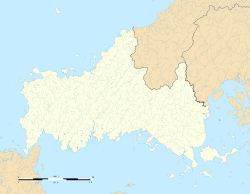Top Qs
Timeline
Chat
Perspective
Agawa Station
Railway station in Shimonoseki, Yamaguchi Prefecture, Japan From Wikipedia, the free encyclopedia
Remove ads
Agawa Station (阿川駅, Agawa-eki) is a JR West San'in Main Line railway station located in the Hōhoku area of the city of Shimonoseki, Yamaguchi Prefecture, Japan. It is operated by the West Japan Railway Company (JR West).[1] It was one of the stations on the Misuzu Shiosai train, which ran between Nagatoshi and Hatabu.
Remove ads
Lines
Agawa Station is served by the JR West San'in Main Line, and is located 627.4 kilometers from the terminus of the line at Kyoto.
Station Layout
The station has two side platforms, serving two tracks, enabling passengers to change trains via a footbridge. The station building had retained its traditional wooden structure for many years, but was replaced in 2020 with a modern steel and glass building The station is run by the Nagato Railroad Bureau. Agawa Station is a Kan'i itaku station. Though there are no staff members, standard tickets can be purchased from a small shop a short distance from the station.
Remove ads
Platforms
| 1 | ■ San'in Main Line | for Nagato-Awano, Igami, Hitomaru, and Nagatoshi |
| 2 | ■ San'in Main Line | for Kottoi, Takibe, Nagato-Futami, and Shimonoseki |
History
- 9 September 1928 - The extension of the Japanese National Rail Kogushi Line, as it was then known, from Takibe Station, is completed. Agawa Station became the new final stop and began servicing customer as well as freight trains.
- 7 December 1930 - The extension of the Mine Line, as it was then known, from Nagato-Furuichi Station is completed. Agawa Station becomes the border point between the Mine Line and the Kogushi Line.
- 24 February 1933 - The Kogushi Line and Mine Line are incorporated into the San'in Main Line.
- 1 June 1963 - The service of freight trains is cancelled.[2]
- 1 April 1987 - Under the privatisation of Japan's railways, Agawa Station becomes part of the West Japan Railway Company.[2]
Remove ads
Passenger statistics
In fiscal 2020, the station was used by an average of 29 passengers daily.[3]
Surrounding area
- Agawa Beach
- The Agawamōri Family Graveyard
- Agawa Post Office
- Japan National Route 191
- Okitagawa
See also
References
External links
Wikiwand - on
Seamless Wikipedia browsing. On steroids.
Remove ads




